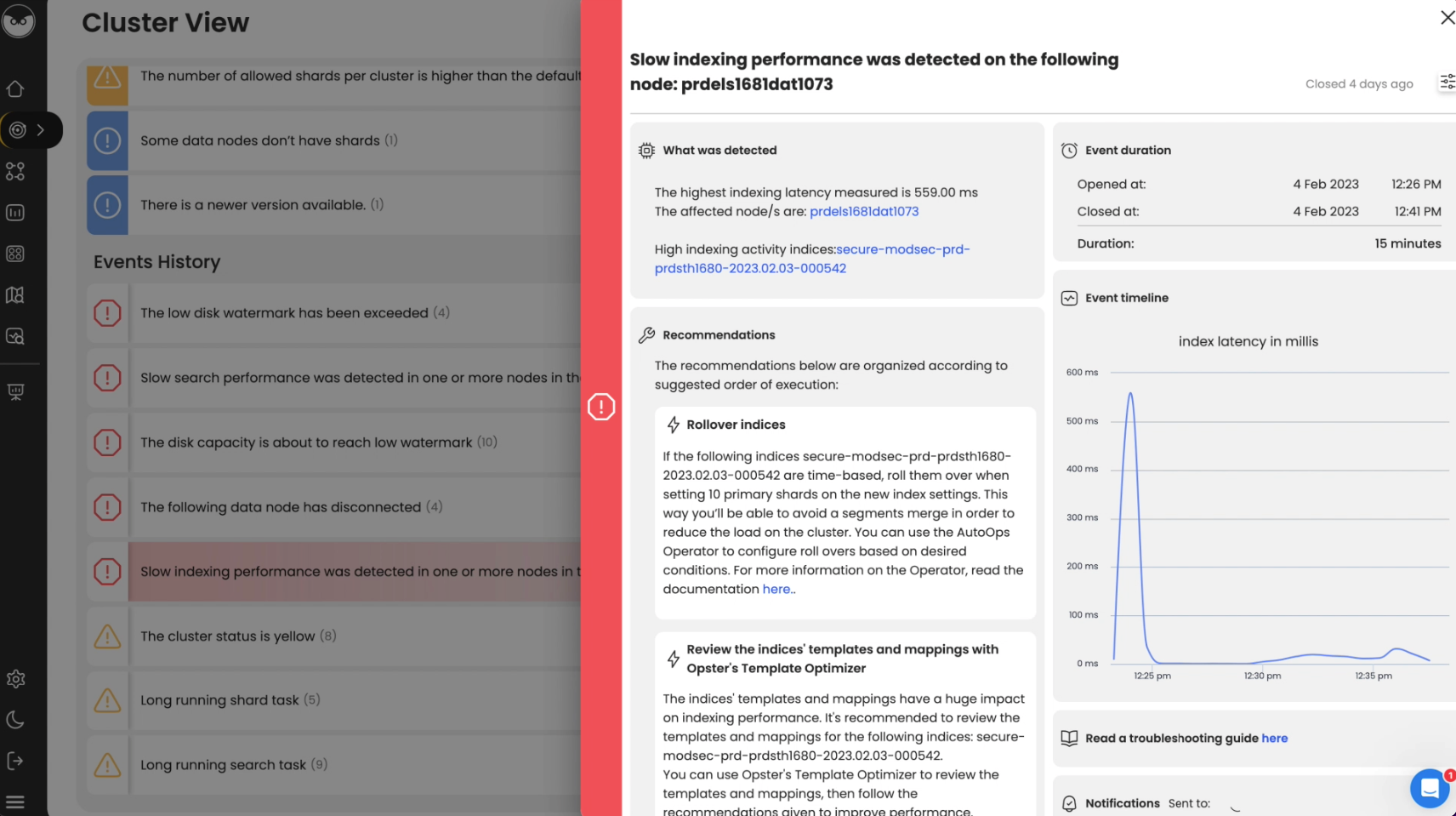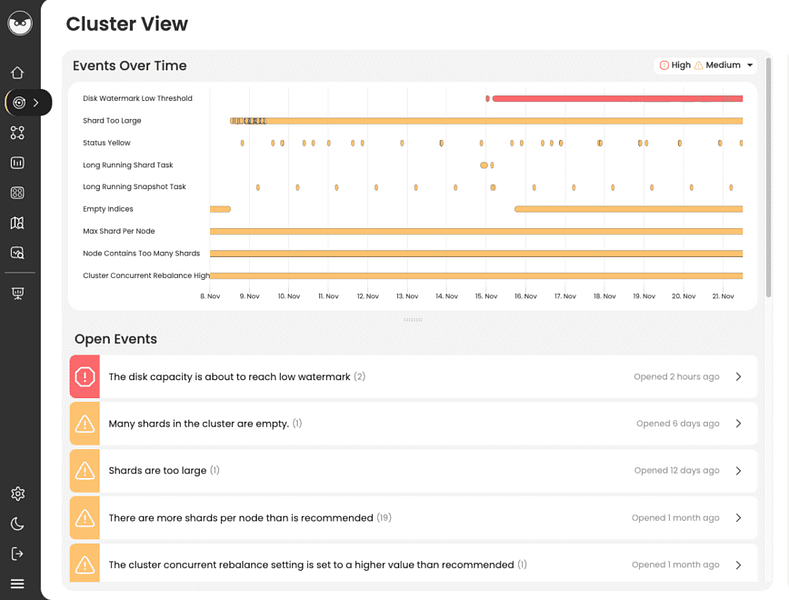Opster Team
Before you begin reading this guide, we recommend you try running the Elasticsearch Error Check-Up which analyzes 2 JSON files to detect many configuration errors.
Briefly, this error message indicates that the enabled parameter was used in an object mapping, but it cannot be updated. The enabled parameter is used to control whether or not a field is indexed in Elasticsearch. To resolve this issue, you should create a new object mapping without the enabled parameter and reindex your data into the new mapping. Alternatively, you can create a new index with the updated object mapping and reindex your data into the new index.
To easily locate the root cause and resolve this issue try AutoOps for Elasticsearch & OpenSearch. It diagnoses problems by analyzing hundreds of metrics collected by a lightweight agent and offers guidance for resolving them.
Take a self-guided product tour to see for yourself (no registration required).
This guide will help you check for common problems that cause the log ” the enabled parameter can’t be updated for the object mapping ” + name() + ” ” to appear. To understand the issues related to this log, read the explanation below about the following Elasticsearch concepts: mapping and index.
Overview
Mapping is similar to database schemas that define the properties of each field in the index. These properties may contain the data type of each field and how fields are going to be tokenized and indexed. In addition, the mapping may also contain various advanced level properties for each field to define the options exposed by Lucene and Elasticsearch. You can create a mapping of an index using the _mappings REST endpoint. The very first time Elasticsearch finds a new field whose mapping is not pre-defined inside the index, it automatically tries to guess the data type and analyzer of that field and set its default value. For example, if you index an integer field without pre-defining the mapping, Elasticsearch sets the mapping of that field as long.
Examples
Create an index with predefined mapping:
PUT /my_index?pretty
{
"settings": {
"number_of_shards": 1
},
"mappings": {
"properties": {
"name": {
"type": "text"
},
"age": {
"type": "integer"
}
}
}
}Create mapping in an existing index:
PUT /my_index/_mapping?pretty
{
"properties": {
"email": {
"type": "keyword"
}
}
}View the mapping of an existing index:
GET my_index/_mapping?pretty
View the mapping of an existing field:
GET /my_index/_mapping/field/name?pretty
Notes
- It is not possible to update the mapping of an existing field. If the mapping is set to the wrong type, re-creating the index with updated mapping and re-indexing is the only option available.
- In version 7.0, Elasticsearch has deprecated the document type and the default document type is set to _doc. In future versions of Elasticsearch, the document type will be removed completely.
Common problems
- The most common problem in Elasticsearch is incorrectly defined mapping which limits the functionality of the field. For example, if the data type of a string field is set as text, you cannot use that field for aggregations, sorting or exact match filters. Similarly, if a string field is dynamically indexed without predefined mapping, Elasticsearch automatically creates two fields internally. One as a text type for full-text search and another as keyword type, which in most cases is a waste of space.
- Elasticsearch automatically creates an _all field inside the mapping and copies values of each field of a document inside the _all field. This field is used to search text without specifying a field name. Make sure to disable the _all field in production environments to avoid wasting space. Please note that support for the _all field has been removed in version 7.0.
- In versions lower than 5.0, it was possible to create multiple document types inside an index, similar to creating multiple tables inside a database. In those versions, there were higher chances of getting data types conflicts across different document types if they contained the same field name with different data types.
- The mapping of each index is part of the cluster state and is managed by master nodes. If the mapping is too big, meaning there are thousands of fields in the index, the cluster state grows too large to be handled and creates the issue of mapping explosion, resulting in the slowness of the cluster.

Index and indexing in Elasticsearch - 3 min
Overview
In Elasticsearch, an index (plural: indices) contains a schema and can have one or more shards and replicas. An Elasticsearch index is divided into shards and each shard is an instance of a Lucene index.
Indices are used to store the documents in dedicated data structures corresponding to the data type of fields. For example, text fields are stored inside an inverted index whereas numeric and geo fields are stored inside BKD trees.
Examples
Create index
The following example is based on Elasticsearch version 5.x onwards. An index with two shards, each having one replica will be created with the name test_index1
PUT /test_index1?pretty
{
"settings" : {
"number_of_shards" : 2,
"number_of_replicas" : 1
},
"mappings" : {
"properties" : {
"tags" : { "type" : "keyword" },
"updated_at" : { "type" : "date" }
}
}
}List indices
All the index names and their basic information can be retrieved using the following command:
GET _cat/indices?v
Index a document
Let’s add a document in the index with the command below:
PUT test_index1/_doc/1
{
"tags": [
"opster",
"elasticsearch"
],
"date": "01-01-2020"
}Query an index
GET test_index1/_search
{
"query": {
"match_all": {}
}
}Query multiple indices
It is possible to search multiple indices with a single request. If it is a raw HTTP request, index names should be sent in comma-separated format, as shown in the example below, and in the case of a query via a programming language client such as python or Java, index names are to be sent in a list format.
GET test_index1,test_index2/_search
Delete indices
DELETE test_index1
Common problems
- It is good practice to define the settings and mapping of an Index wherever possible because if this is not done, Elasticsearch tries to automatically guess the data type of fields at the time of indexing. This automatic process may have disadvantages, such as mapping conflicts, duplicate data and incorrect data types being set in the index. If the fields are not known in advance, it’s better to use dynamic index templates.
- Elasticsearch supports wildcard patterns in Index names, which sometimes aids with querying multiple indices, but can also be very destructive too. For example, It is possible to delete all the indices in a single command using the following commands:
DELETE /*
To disable this, you can add the following lines in the elasticsearch.yml:
action.destructive_requires_name: true
Log Context
Log “the [enabled] parameter can’t be updated for the object mapping [” + name() + “]”classname is ObjectMapper.java We extracted the following from Elasticsearch source code for those seeking an in-depth context :
if (reason == MergeReason.INDEX_TEMPLATE) {
if (mergeWith.enabled.explicit()) {
this.enabled = mergeWith.enabled;
}
} else if (isEnabled() != mergeWith.isEnabled()) {
throw new MapperException("the [enabled] parameter can't be updated for the object mapping [" + name() + "]");
}
for (Mapper mergeWithMapper : mergeWith) {
Mapper mergeIntoMapper = mappers.get(mergeWithMapper.simpleName());
Find & fix Elasticsearch problems
Opster AutoOps diagnoses & fixes issues in Elasticsearch based on analyzing hundreds of metrics.
Fix Your Cluster IssuesConnect in under 2 minutes

Matt Watson
CTO at Stackify





